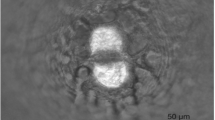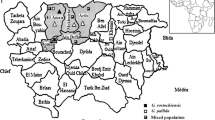Abstract
Graminaceous cyst nematodes form a group of eleven valid species including Heterodera avenae, Heterodera filipjevi and Heterodera latipons and constitute major pests to cereals. They are widely spread in circum-mediterranean areas where they are presumed to cause yield losses on bread and durum wheat. The objective was to document the diversity of these cereal cyst nematodes, in particular samples from Mediterranean regions, in comparison to species which develop on cultivated or wild grasses (H. arenaria, H. hordecalis, H. mani) and on rice or sugarcane (H. sacchari). Studies involved PCR-RFLP of ITS and morphometrics of the juvenile and cyst characters. UPGMA analysis of molecular data showed that the isolates segregated in two main clusters which seem to represent different evolutionary lineages. The H. avenae sensu lato cluster (I) contained H. arenaria, H. avenae, H. filipjevi and H. mani. The second cluster (II) contained isolates of H. hordecalis and H. latipons. Within H. avenae sensu lato, H. filipjevi was separated from the other related species with significant bootstrap value. The differentiation of H. arenaria, recognized for the first time based on molecular data, and H. mani with few restriction enzymes were the least significant. Intraspecific polymorphism allowed differentiation of isolates originating from Australia within H. avenae sensu stricto. The group H. hordecalis–H. latipons showed the greatest genetic variability between and within isolates. Two representatives of Heterodera sacchari, taxonomically included in the ‘schachtiigrave’ group, were genetically as distant to this group as to the other graminaceous species belonging to either H. avenae sensu lato or H. hordecalis–H. latipons group. Results inferred from multivariate analysis applied on morphometrics of the cysts and juveniles showed agreement between genetic and phenotypic classifications. This study demonstrates the utility of combined molecular and classical methods to enhance our knowledge about the diversity within the complex of graminaceous cyst nematodes and to establish robust techniques to identify a wider set of nematode species.
Similar content being viewed by others
References
Andrés MF, Romero MD, Montes MJ and Delibes A (2001) Genetic relationships and isozyme variability in the Heterodera avenae complex determined by isoelectrofocusing. Plant Pathology 50: 270-279
Baldwin JG (1992) Evolution of cyst and non cyst-forming Heteroderinae. Annual Review of Phytopathology 30: 271-290
Bekal S, Gauthier JP and Rivoal R (1997) Genetic diversity among a complex of cereal cyst nematodes inferred from RFLP analysis of the ribosomal internal transcribed spacer region. Genome 40: 479-486
Blok VC, Malloch G, Harrower B, Phillips MS and Vrain TC (1998) Intraspecific variation in ribosomal DNA in isolates of the potato cyst nematode Globodera pallida. Journal of Nematology 30: 262-274
Clapp JP, Van der Stoel CD and Van der Putten WH (2000) Rapid identification of cyst (Heterodera spp., Globodera spp.) and root-knot (Meloidogyne spp.) nematodes on the basis of ITS2 sequence variation detected by PCR-single-strand conformational polymorphism (PCR-SSCP) in cultures and field samples. Molecular Ecology 9: 1223-1232
Cook R (1982) Cereal and grass hosts of some gramineous cyst nematodes. EPPO Bulletin 12: 399-411
Cook R and Rivoal R (1998) Genetics of resistance and parasitism. In: Sharma SB (ed) The Cyst Nematodes (pp 322-352) Chapman and Hall, London
Felsenstein J (1985) Confidence limits on phylogenies: An approach using the bootstrap. Evolution 39: 783-791
Felsenstein J (1993) PHYLIP (phylogeny inference package). Version 3.5c. Distributed by the author. Department of Genetics, University of Washington, Seattle
Ferris VR (1979) Cladistic approaches in study of soil and plant parasitic nematodes. American Zoology 19: 1195-1215
Ferris VR (1985) Evolution and biogeography of cyst-forming nematodes. EPPO Bulletin 15: 123-129
Ferris VR (1994) The future of nematode systematics. Fundamental and Applied Nematolology 17: 97-101
Ferris VR (1998) Evolution, phylogeny and systematics. In: Sharma SB (ed) The Cyst Nematodes (pp 57-82) Chapman and Hall, London
Ferris VR, Ferris JM and Faghihi J (1993) Variation in spacer ribosomal DNA in some cyst-forming species of plant parasitic nematodes. Fundamental and Applied Nematology 16: 177-184
Ferris VR, Ferris JM, Faghihi J and Ireholm A (1994) Comparisons of isolates of Heterodera avenae using 2-D PAGE protein patterns and ribosomal DNA. Journal of Nematology 26: 144-151
Ferris VR, Subbotin SA, Ireholm A, Spiegel Y, Faghhihi J and Ferris J (1999) Ribosomal DNA sequence analysis of Heterodera filipjevi and H. latipons isolates from Russia and comparisons with other nematode isolates. Russian Journal of Nematology 7: 121-125
Hillis DM and Dixon MT (1991) Ribosomal DNA: Molecular evolution and phylogenetic inference. The Quarterly Review of Biology 66: 411-453
Hooper DJ (1970) Handling, fixing, staining and mounting nematodes. In: Southey JF (ed) Laboratory Methods for Work with Plant and Soil Nematodes. Technical Bulletin 2 (pp 39-54) Her Majesty's Stationery office, London
Ibrahim SK and Rowe JA (1995) Use of isoelectric focusing and polyacrylamide gel electrophoresis of nonspecific esterase phenotypes for the identification of cyst nematodes Heterodera species. Fundamental and Applied Nematology 18: 189-196
Iwahori H, Tsuda K, Kanzaki N, Izui K and Futai K (1998) PCR-RFLP and sequencing analysis of ribosomal DNA of Bursaphelenchus nematodes related to pine wilt disease. Fundamental and Applied Nematology 21: 655-666
Lebart L, Morineau A and Piron M (2000) Statistique exploratoire multidimensionnelle. 3rd edn, Dunod (ed) Paris, 439 p
Luc M and Merny G (1963) Heterodera sacchari n.sp. (Nematoda: Tylenchoidea) parasite de la canne à sucre au Congo-Brazzaville. Nematologica 9: 31-37
Madzhidov AR (1981) [Bidera filipjevi n.sp. (Heteroderina: Tylenchida) in Tadzhikistan.] Izvestiya Akademii Nauk Tadzhikskoï SSR, Biologicheskie Nauki 2: 40-44
Mathews HJP (1971) Two new species of cyst nematode, Heterodera mani n.sp. and H. iri n.sp., from Northern Ireland. Nematologica 17: 553-565
Mor M and Sturhan D (2000) On the identity of Heterodera latipons Franklin. Nematology 2: 776-777 (abst.)
Mulvey RH (1972) Identification of Heterodera cysts by terminal and cone structures. Canadian Journal of Zoology 50: 1277-1292
Nei M and Li WH (1979) Mathematical model for studying genetic variation in terms of restriction endonucleases. Proceedings of the National Academy of Sciences of the USA 76: 5269-5273
Nicol J (2002) Important nematode pests of cereals. Bread Wheat: Improvement and Production (pp 345-366) FAO Publisher, Rome, Italy
Nobbs JM, Ibrahim SK and Rowe JA (1992) A morphological and biochemical comparison of the four cyst nematode species, Heterodera elasticha, H. oryzicola, H. oryzae and H. sacchari (Nematoda: Heteroderidae) known to attack rice (Oryza sativa). Fundamental and Applied Nematolology 15: 551-562
Powers TO, Todd TC, Burnell AM, Murray PCB, Fleming CC, Szalanski AL, Adams BAA and Harris TS (1997) The rDNA internal transcribed spacer region as a taxonomic marker for nematodes. Journal of Nematology 29: 441-450
Reed DH and Frankham R (2001) How closely correlated are molecular and quantitative measures of genetic variation? A meta-analysis. Evolution 55: 1095-1101
Rivoal R, Bekal S, Valette S, Gauthier JP, Bel Hadj Fradj M, Mokabli A, Jahier J, Nicol J and Yahyaoui A (2001) Variation in reproductive capacity and virulence on different genotypes and resistance genes of Triticeae, in the cereal cyst nematode complex. Nematology 3: 581-592
Rivoal R and Cook R (1993) Nematode pests of cereals. In: Evans K, Trudgill DL and Webster JM (eds) Plant Parasitic Nematodes in Temperate Agriculture (pp 259-303) CAB International, Wallingford
Ritter M (1982) Importance des nématodes à kystes des céréales. Bulletin OEPP 12: 307-316
Rumpenhorst HJ, Elekçioglu IH, Sturhan D, Öztürk G and Enneli S (1996) The cereal cyst nematode Heterodera filipjevi (Madzhidov) in Turkey. Nematologia Mediterranea 24: 135-138
Sabo A, Volvas N and Ferris VR (2001) Phylogenetic relationships based on ribosomal DNA data for four species of cyst nematodes from Italy and one from Syria. Journal of Nematology 33: 183-190
Sikora RA (1987) Plant parasitic nematodes of wheat and barley in temperate and temperate semiarid regions-a comparative analysis. In: Saxena MC, Sikora RA and Srivastava JP (eds) Nematodes Parasitic to Cereals and Legumes in Temperate Semi-arid Regions (pp 46-68) Proc. Workshop, Larnaca, Cyprus
Solignac M (1995) Evolution concertée des séquences répétées. In: Hermann (ed) Génétique et évolution, Tome II. L'espèce, l'évolution moléculaire (pp 237-255) Paris
Sturhan D (1982) Distribution of cereal and grass cyst nematodes in the Federal Republic of Germany. EPPO Bulletin 12: 321-324
Sturhan D (1996) Occurrence of Heterodera filipjevi (Madzhidov, 1981; Stelter, 1984) in Iran. Pakistan Journal of Nematology 14: 89-93
Subbotin SA, Waeyenberge L and Moens M (2000) Identification of cyst forming nematodes of the genus Heterodera (Nematoda: Heteroderidae) based on the ribosomal DNARFLP. Nematology 2: 153-164
Subbotin SA, Waeyenberge L, Molokanova IA and Moens M (1999) Identification of Heterodera avenae group species by morphometrics and rDNA-RFLPs. Nematology 1: 195-207
Szalanski AL, Sui DD, Harris TS and Powers TO (1997) Identification of cyst nematodes of agronomic and regulatory concern with PCR-RFLP of ITS1. Journal of Nematology 29: 255-267
Thiéry M and Mugniéry D (1996) Interspecific rDNA restriction fragment length polymorphism in Globodera species, parasites of Solanaceous plants. Fundamental and Applied Nematology 19: 471-479
Volvas V, Greco N and Di Vito M (1985) Heterodera ciceri sp.n. (Nematoda: Heteroderidae) on Cicer arietinum L. from Northern Syria. Nematologia Mediterranea 13: 239-252
Vrain TC, Wakarchuk DA, Lévesque AC and Hamilton RI (1992) Intraspecific rDNA restriction fragment length polymorphism in the Xiphinema americanum group. Fundamental and Applied Nematology 15: 563-573
Waeyenberge L, Ryss A, Moens M, Pinochet J and Vrain TC (2000) Molecular characterization of 18 Pratylenchus species using rDNA restriction fragment length polymorphism. Nematology 2: 135-142
Wouts WW, Schoemaker A, Sturhan D and Burrows PR (1995) Heterodera spinicauda sp.n. (Nematoda: Heteroderidae) from mud flats in the Netherlands, with a key to the species of the H. avenae group. Nematology 41: 575-583
Zheng J, Subbotin S, Waeyenberge L and Moens M (2000) Molecular characterisation of Chinese Heterodera glycines and H. avenae populations based on RFLPs and sequences of rDNA-ITS regions. Russian Journal of Nematology 8: 109-113
Author information
Authors and Affiliations
Rights and permissions
About this article
Cite this article
Rivoal, R., Valette, S., Bekal, S. et al. Genetic and Phenotypic Diversity in the Graminaceous Cyst Nematode Complex, Inferred from PCR-RFLP of Ribosomal DNA and Morphometric Analysis. European Journal of Plant Pathology 109, 227–241 (2003). https://doi.org/10.1023/A:1022838806268
Issue Date:
DOI: https://doi.org/10.1023/A:1022838806268




